MICKEY
MOUSE
Biography *
Evolution
of the design *
Mickey around
the world
IT
ALL BEGAN WITH A MOUSE!
 MICKEY
MOUSE, Walt Disney's most famous character, made his screen debut on November
18, 1928, as star of the first sound cartoon, Steamboat Willie.
Since his debut, Mickey Mouse has become an international personality whose
success laid the financial foundation upon which Walt Disney built his
creative organization. Besides being the personification of everything
Disney, Mickey Mouse has become one of the most universal symbols of the
Twentieth Century.
MICKEY
MOUSE, Walt Disney's most famous character, made his screen debut on November
18, 1928, as star of the first sound cartoon, Steamboat Willie.
Since his debut, Mickey Mouse has become an international personality whose
success laid the financial foundation upon which Walt Disney built his
creative organization. Besides being the personification of everything
Disney, Mickey Mouse has become one of the most universal symbols of the
Twentieth Century.
Mickey Mouse was born in Walt Disney's imagination early in 1928
on a train ride from New York to Los Angeles. Walt was returning with
his wife from a business meeting at which his cartoon creation, Oswald
the Rabbit, had been wrestled from him by his financial backers. Only
26 at the time and with an active cartoon studio in Hollywood, Walt had
gone east to arrange for a new contract and more money to improve the quality
of his Oswald pictures. The moneymen declined, and since the character
was copyrighted under their name, they took control of it. "... So I was
all alone and had nothing," Walt recalled later. "Mrs. Disney and I were
coming back from New York on the train and I had to have something I could
tell them. I've lost Oswald so, I had this mouse in the back of my head
because a mouse is sort of a sympathetic character in spite of the fact
that everybody's frightened of a mouse including myself" Walt spent the
return train ride conjuring up a little mouse in red velvet pants and named
him "Mortimer," but by the time the train screeched into the terminal station
in Los Angeles, the new dream mouse had been rechristened. Walt's wife,
Lillian, thought the name "Mortimer" was too pompous and suggested "Mickey."
A star was born!
Upon returning to his studio, Walt and his head animator, Ub Iwerks,
immediately began work on the first Mickey Mouse cartoon, Plane
Crazy. The enthusiasm with which his small staff completed
the project faded when no distributor wanted to buy the film. Refusing
to give in, Walt forged into production on another silent Mickey Mouse
cartoon, Gallopin'Gaucho. However, late in 1927, Warner Brothers
ushered in the talkies with The Jazz Singer, staffing Al Jolson.
This soon signaled the end of silent films so, in 1928, Walt dropped everything
to begin a third Mickey Mouse cartoon, this one in sound: Steamboat
Willie.
 To
record the sound track, Walt had to take his film to New York, since no
one on the West Coast was equipped to do it. Walt sank everything he had
into the film. When finally completed, Walt screened it for the New York
exhibitors. The manager at the Colony Theatre liked the eager young producer
and decided to take a chance on his film. Steamboat
Willie scored an overwhelming success, and Walt soon became
the talk of the nation. Buoyed by the artistic and popular success of Steamboat
Willie, Disney added sound to the first two cartoons and was able to offer
exhibitors a package of three shorts. As with all of Mickey Mouse's pictures
through World War II, Walt himself supplied the voice. Then in 1946, when
Walt became too busy to continue, Jim Macdonald, veteran Disney sound and
vocal effects man, tookover. ( Jim Macdonald continued to provide the voice
of Mickey Mouse for nearly thirty years, until he retired in 1974. Following
his retirement, Wayne Allbright was selected to perform the voice of Mickey
Mouse. Wayne has provided Mickey Mouse's vocal characterizations in his
most recent screen appearances ).
To
record the sound track, Walt had to take his film to New York, since no
one on the West Coast was equipped to do it. Walt sank everything he had
into the film. When finally completed, Walt screened it for the New York
exhibitors. The manager at the Colony Theatre liked the eager young producer
and decided to take a chance on his film. Steamboat
Willie scored an overwhelming success, and Walt soon became
the talk of the nation. Buoyed by the artistic and popular success of Steamboat
Willie, Disney added sound to the first two cartoons and was able to offer
exhibitors a package of three shorts. As with all of Mickey Mouse's pictures
through World War II, Walt himself supplied the voice. Then in 1946, when
Walt became too busy to continue, Jim Macdonald, veteran Disney sound and
vocal effects man, tookover. ( Jim Macdonald continued to provide the voice
of Mickey Mouse for nearly thirty years, until he retired in 1974. Following
his retirement, Wayne Allbright was selected to perform the voice of Mickey
Mouse. Wayne has provided Mickey Mouse's vocal characterizations in his
most recent screen appearances ).
Mickey Mouse started his career as what has been described as "at best
a fresh and bratty kid, at worst a dimunitive and sadistic monster". In
Steamboat
Willie, he honked ducks with tight hugs, uses the teeth of a cow as
a xylophone, and winds the tail of a goat like a music box. Mickey wasn't
truly depraved; he just engaged in "pure, amoral, very boyish mischief".
Because Mickey was somewhat fashioned after Charlie Chaplin, there were
many similarities between these two characters.
Parents were alarmed with Mickey's obnoxious and crass behavior;
a deluge of letters flooded Walt Disney's office, demanding a "kinder,
gentler" mouse. Accompanying Mickey's physical makeover came a definite
shift in behavior. Mickey was no longer loud and brash, but more quiet
and charming. Mickey, then and now, is not particularly funny; he is attractive
in a pleasant and appealing fashion. This is a trait that was inherited
from Disney himself, who was not known to be truly humorous. Mickey abandoned
slapsick comedy; he would forever be destined to be a "nice guy" with this
major alteration.
Mickey Mouse's skyrocket to fame didn't take long. His cartoons became
so popular that people would first ask ticket takers if they were "running
a Mickey" before they would purchase admission. Soon, theaters were displaying
posters that read "Mickey Mouse playing today!" It was not uncommon for
patrons to sit through a feature twice to see him again. The
thirties was Mickey Mouse's golden age; 87 cartoon shorts starring
the multi-talented mouse were produced by Walt Disney during that decade.
He played everything from fireman to giant killer, cowboy to inventor,
detective to plumber. Technically and artistically Mickey Mouse cartoons
were far superior to other contemporary cartoons and gave life to an entire
family of animated characters: Minnie Mouse, Clarabelle Cow, Horace Horsecollar,
Goofy, Pluto, Donald Duck, Peg-Leg Pete, and many others.
 The
artistic success of the animators was honored in 1932 when an Oscar was
presented to Walt Disney for the creation of Mickey Mouse. Mickey Mouse's
popularity spawned a Mickey Mouse Club in 1929 which met every Saturday
for an afternoon of cartoons and games in local theaters. The several million
Mouse Clubbers had a secret handshake, special member greeting, code of
behavior, and even a special club song, "Minnie's Yoo Hoo". The peak of
Mickey Mouse's golden decade was his starring role as the Sorcerer's Apprentice
in the feature Fantasia (1940), a major
artistic innovation. It interpreted music in colors, shapes, movement,
and story. The animation techniques were years ahead of their time and
have never been matched. Fantasia also introduced stereophonic sound to
theaters, an element not employed by other studios until more than a decade
later.
The
artistic success of the animators was honored in 1932 when an Oscar was
presented to Walt Disney for the creation of Mickey Mouse. Mickey Mouse's
popularity spawned a Mickey Mouse Club in 1929 which met every Saturday
for an afternoon of cartoons and games in local theaters. The several million
Mouse Clubbers had a secret handshake, special member greeting, code of
behavior, and even a special club song, "Minnie's Yoo Hoo". The peak of
Mickey Mouse's golden decade was his starring role as the Sorcerer's Apprentice
in the feature Fantasia (1940), a major
artistic innovation. It interpreted music in colors, shapes, movement,
and story. The animation techniques were years ahead of their time and
have never been matched. Fantasia also introduced stereophonic sound to
theaters, an element not employed by other studios until more than a decade
later.
With the advent of World War II, the Disney Studio suspended nearly
all commercial activity and concentrated on aiding the war effort with
training films, goodwill tours, and designing of posters and armed forces
insignia. Mickey Mouse played his part by appearing on insignia and posters
urging national security and the purchase of war bonds. And, incredibly,
the password of the Allied forces on D-Day, June 6,1944, was "Mickey Mouse."
Following the war, Mickey Mouse returned to making cartoons and appeared
in his second feature, Fun and Fancv
Free (1947), in which he co-starred with Goofy and Donald Duck
in a new version of "Jack and the Beanstalk," titled appropriately "Mickey
and the Beanstalk."
Through the forties and early fifties, Mickey Mouse made fewer cartoons,
giving ground to Donald Duck, Goofy, and Pluto, who were more flexible
as characters. After World War II, Mickey ranked third in a poll regarding
favorite cartoon characters -Donald Duck took first while Bugs Bunny landed
second. Mickey Mouse's evolution into a Disney symbol made it increasingly
more difficult to create story situations for him. If he lost his temper
or did anything sneaky, fans would write in insisting that Mickey Mouse
just wouldn't do that. Consequently, Walt Disney was against making
more movies with Mickey because the variety of acting Mickey could do was
limiting. He claimed that Mickey had turned into an idol and unlike Donald
Duck could not be manipulated. "The Duck can blow
his top and commit mayhem, but if I do anything like that with the mouse,
I get letters from all over the world. 'Mickey wouldn't act like that'."
No more Mickey movies would be made for thirty years!
 After
the success of the Disneyland television show in 1954, Disney agreed the
next year to create an afternoon program for ABC. He gave them The Mickey
Mouse Club, which became the most successful children's show ever. In 1977,
The New Mickey Mouse Club, featuring 12 new Mouseketeers, debuted on television,
and a third generation of Mouseketeers hit the airwaves in 1989 when The
Mickey Mouse Club debuted as a series on The Disney Channel with shows
airing on weekday afternoons.
After
the success of the Disneyland television show in 1954, Disney agreed the
next year to create an afternoon program for ABC. He gave them The Mickey
Mouse Club, which became the most successful children's show ever. In 1977,
The New Mickey Mouse Club, featuring 12 new Mouseketeers, debuted on television,
and a third generation of Mouseketeers hit the airwaves in 1989 when The
Mickey Mouse Club debuted as a series on The Disney Channel with shows
airing on weekday afternoons.
Mickey Mouse moved to Disneyland in 1955 to become chief host of the
theme park, welcoming millions of visitors annually, shaking hands, posing
for pictures, and leading the big parades on national holidays. In 1971,
he helped open the Walt Disney World Resort; in 1983 he donned a kimono
for the dedication of Tokyo Disneyland; and in 1992, he sported a beret
for the opening of what is now called Disneyland Paris. His other activities
include public appearance tours around the world for The Walt Disney Company.
Mickey Mouse has been saluted at three of the Disney theme parks by
having "lands" created in his honor. Mickey's Birthdayland (now Mickey's
Starland) opened on November 18, 1988, in the Magic Kingdom in Walt Disney
World to honor Mickey Mouse on his 60th birthday. Mickey's Toontown opened
in 1993 in Disneyland, then in 1996 at Tokyo Disneyland and now serves
as home to Mickey Mouse and all of his cartoon friends.
"Sometimes I've tried to figure out why Mickey
appealed to the whole world," Walt Disney admitted. "Everybody's
tried to figure it out. So far as I know, nobody has. He's a pretty nice
fellow who never does anybody any harm, who get into scrapes through no
fault of his own, but always managed to come up grinning."
It is this very humble and common image of Mickey which has allowed for
his evolution and made him applicable to every element of society. After
all these years, the cultists are beginning to understand why the Mickey
Mouse of the thirties was so popular. He was a little guy born out of the
depression who satirized people's foibles and taught them to laugh. Most
importantly, he was a character who dreamed big, and his dreams were universal.
One of the finest tributes to Mickey Mouse was given by Walt Disney
himself when, on his first television show as he surveyed Disneyland, Walt
said, "I hope we never lose sight of one fact... that this was all started
by a Mouse."
THE
EVOLUTION OF MICKEY MOUSE
| The Neanderthal Mickey. Walt Disney's success
began with this rabbit he dubbed "Oswald", one Disney's first characters.
He did not own the rights to this cartoon, however, and thus Oswald the
Rabbit (as property) was taken from Walts' hands when the rabbit grew in
popularity. Disney would not tolerate such unjust theft, so he, along with
Oswald, abandoned Disney's employer at the time.
From there, Disney bounced from studio to studio, generating different
animated shorts. His ultimate success came after some brainstorming with
his wife on a train, where Disney thought up of a character known as Mickey
Mouse (Mickey was originally to be named "Mortimer", but Mrs. Disney felt
that it lacked charm). Observe the similarities in facial structure, body
shape, and apparel between Oswald the Rabbit and Mickey Mouse. |
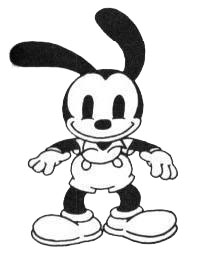
Oswald the Rabbit (<1928)
|
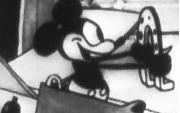
Plane Crazy (1928)
|
Mickey Mouse in his original form. Note the large eye sockets, oblong
snout, and gloveless hands. The ears are placed in an awkward position
on his head and the limbs resemble pipestems. However, the infamous two-button
shorts have been established. |
| How the public first saw Mickey Mouse
on November 18th, 1928 (recognized as Mickey's birthday). Black circles
have now replaced the huge eye sockets. Note that shoes adorn Mickey's
feet, but he is lacking gloves. He still has the beanpole limbs and the
very full pear body shape. Ears are becoming more separated (however, this
isn't a static trait; they go all over the place). Tail is at a long length. |

Steamboat Willie (1928)
|
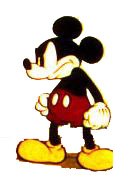
Mickey's Rival (1936)
|
Near the end of Mickey Mouse's character reformation. Gloves have finally
been introduced (to make him more human). He has gained some weight and
his limbs are not as reminiscent of beanpoles anymore. Snout has been rounded
out and shortened. The feet are larger as well. His movements are more
fluid and his flexibility has increased. |
| The beginning of Mickey Mouse's decline. There is now a hint of color
in his face and pants cover his legs. His infamous black ears are no longer
eternal circles; they actually change form when viewed from different angles.
The eye sockets have been reintroduced and the tail has been shortened
(the tail actually disappeared during World War II because it was too difficult
to animate-- but it also saved some money). The pear body shape has been
smoothed out and Mickey adopts a classy wardrobe. |
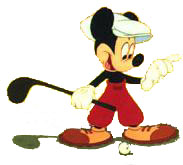
Canine Caddy (1941)
|

Generic Mickey (present)
|
How Mickey Mouse is generally seen animated today. Eyes have narrowed
into tight ellipses and he has wider temples (well, in any case, there's
more room between his eyes and his ears). Ears are definitely more separated
and the eternal black circles have returned. The nose is more wide than
long. Always handsomely dressed to match his smooth figure. |
MICKEY
AROUND THE WORLD
| Arabic |
Mickey |
|
Hungarian |
Miki Egér |
| Bulgarian |
Miki Maus |
|
Icelandic |
Mikki Mús |
| Chinese |
Mi Lao Shu |
|
Indonesian |
Miki Tikus |
| Czech |
Mickey Mouse |
|
Italian |
Topolino |
| Danish |
Mickey Mouse |
|
Norwegian |
Mikke Mus |
| Dutch |
Mickey Mouse |
|
Polish |
Myszka Mikey / Miki |
| English |
Mickey Mouse |
|
Portuguese |
Mickey Mouse |
| Estonian |
Mikki Hiir |
|
Russian |
Mikki Maus |
| Faeroese |
Mikkjal Mus |
|
Serbo-Croatian |
Miki Maus |
| Finnish |
Mikki Hiiri |
|
Slovak |
Mysiak Mickey / My`'sjak Miky |
| Flemish |
Mickey Mouse |
|
Spanish (in Spain) |
El Ratón Mickey / Mickey Mouse |
| French |
Mickey |
|
Swedish |
Musse Pigg |
| German |
Micky Maus |
|
Turkish |
Miki |
| Greek |
Mikki Maous |
|
|
|
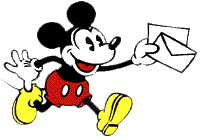
| Join the
Animation Mailing List! |
|
|
|
 MICKEY
MOUSE, Walt Disney's most famous character, made his screen debut on November
18, 1928, as star of the first sound cartoon, Steamboat Willie.
Since his debut, Mickey Mouse has become an international personality whose
success laid the financial foundation upon which Walt Disney built his
creative organization. Besides being the personification of everything
Disney, Mickey Mouse has become one of the most universal symbols of the
Twentieth Century.
MICKEY
MOUSE, Walt Disney's most famous character, made his screen debut on November
18, 1928, as star of the first sound cartoon, Steamboat Willie.
Since his debut, Mickey Mouse has become an international personality whose
success laid the financial foundation upon which Walt Disney built his
creative organization. Besides being the personification of everything
Disney, Mickey Mouse has become one of the most universal symbols of the
Twentieth Century.









